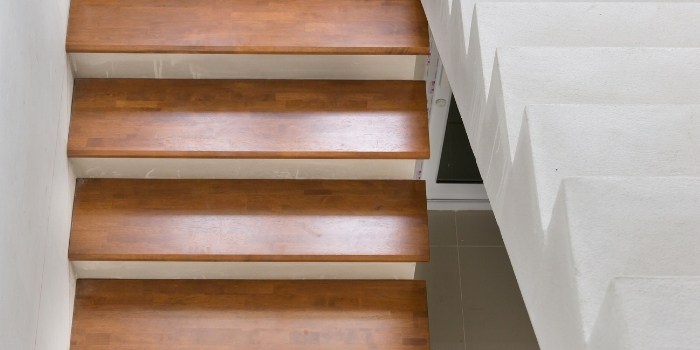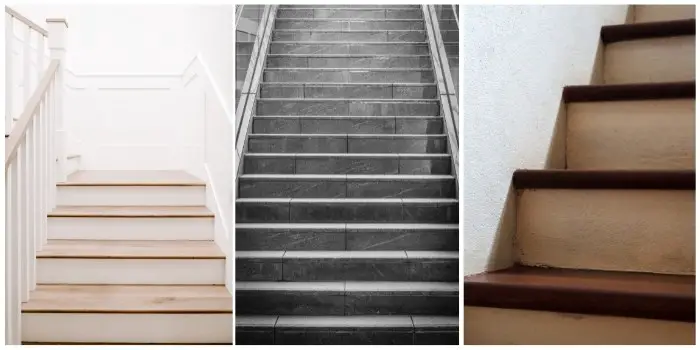
Concrete steps are pretty common – so popular that you may even see them in the basement as part of the layout.
There’s a good reason why concrete steps are so common. They are easy to create and exceptionally durable. With minimal maintenance, they will last for a long time.
The only downside is that concrete steps lack visual appeal compared to steps made from other materials.
However, you can have the best of both worlds by covering your concrete steps with a wooden staircase.
And while it is not that easy to simply cover a concrete staircase with wooden steps, it can be done if you do it correctly.
Below we will take a look at how…
Covering Concrete Steps with Removable Wooden Steps
Now that you know it can be done, the next step is to properly plan and purchase the suitable materials so you can accomplish this task.
Step 1- Purchase the Wood
You will need to get some good-quality wood to make the project work.
This means typically purchasing wood that has already been cut, stained, and treated as a stair step or riser.
Choose the right type that works best for your stairs.
Remember that if you have tile that looks like wood downstairs, you will need to match that tile along with the steps for aesthetic purposes.
In addition, you will need smaller wooden planks, such as 1” x 2”, to complete the project.
The number of planks you need to purchase will be based on the number of steps that are present. Two planks for every step are recommended.
Step 2- Cut
The risers you obtain should be large enough to cover the concrete tread of the step fully. However, you will need to measure the risers and cut the wood to the proper size.
- Measure the height of the riser and trim off the excess. Use a jigsaw or hacksaw to make the cuts.
- Cut the small plants to fit under the treads. Leave enough space to fit the riser’s thickness.
- Ensure that each step has two separate rails.
Step 3- Install
You must create a basic framework that fits the concrete steps. It will need to fit with the concrete to secure the steps.
Start by connecting the joints of the smaller frames together using a hammer.
Use thin nails that are perpendicular to each other. Add another stair tread to the top of the next riser. The result should appear like a “Z” that has been straightened out.
- Two pairs of connected joints for each pair of steps that are covered. The joints should fit smoothly on the concrete.
- Continue until you have enough framing to cover the steps fully
Step 4- Fill with Treads
With the frame in place, you will need to fill the treads. Wood glue is superior compared to the standard nails for this job.
- Glue the riser to the corner of the “Z.” Give both the “Z” an equal space apart. Follow with another tread.
- Continue until you fill in everything with treads and boards until complete.
Step 5- Secure
You will need to secure each step from the bottom of the floor to the top of the stairs.
You can do this by nailing portions of the stairs to the stair railing of the concrete.
Keep in mind that you can bolt the removable part of the stairs to the concrete, but this will make it permanent.
- Nail large pairs of plants from the bottom of the stairs to the wall across them.
- Cover the planks with wooden paneling. This makes them easier to remove.
- Put a lock around the railing

Are Removable Stair Steps Safe?
The removable versions are not going to be as safe compared to steps that are affixed permanently to the concrete.
But they usually are pretty safe and secure when attached properly.
However, if the stairs are taller than 10’, you should consider using permanent steps for falling because a removable step from that height can be quite dangerous.
If you feel that adding removable steps to your concrete stairs is not up to your alley, then consider hiring a professional to do the job.
They have the knowledge, tools, and experience to add removable steps to a set of concrete stairs correctly.
Why Do You Need Removable Steps Over Concrete?
You may be wondering if it is worth adding removable steps to the concrete stairs you already have in place.
After all, you could simply put permanent wooden stairs on the concrete.
Non-removable wooden steps are actually easier to affix. Plus, the stairs will remain sturdy. However, there are advantages to adding removable steps.
The first benefit is if you are renting your home. Removable steps may be the only option in that regard unless the landlord approves.
But there are other reasons as well, which start with cleaning the steps.
It’s easier to clean if you can remove them quickly and efficiently. Plus, you can replace a broken step a lot easier if it is removable.
Are There Other Ways to Get Removable Steps for Concrete Stairs?
There are companies making removable wooden steps for concrete stairs. From them, you can also purchase step pads that can be glued to the concrete.
But the problem with purchasing existing steps is that they need to be the right size.
And given how concrete stairs can vary in size, that may be problematic. In such cases, you are better off making your own steps.
If you are more concerned about having a secure tread added to the concrete stairs, you can use stair tape. This is easy to adhere to, even concrete, and will reduce the chances of slipping considerably.
You will often find stair tape used in industrial buildings and factories where aesthetics is not considered all that important.
If how the steps look with stair tape attached to them does not bother you, then go right ahead and add them. Otherwise, it will not be all that pleasing looking.
Share the post "How Do You Attach Oak Treads to Existing Concrete Stairs?"

Hi, I am Mark Garner a professional carpenter, woodworker, and DIY painter. I live in the small city of Peoria, Arizona as a semi-retired woodworker. I have started this blog with a simple motive to help you with my wood experience in this sector. If you like to know more about what I love doing and how it all got started, you can check more about me here.




